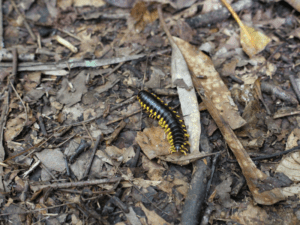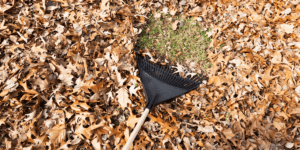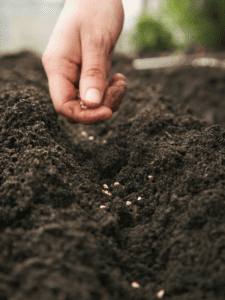Leave the Leaves: Embracing Beautiful Messes in Nature Benefits Wildlife
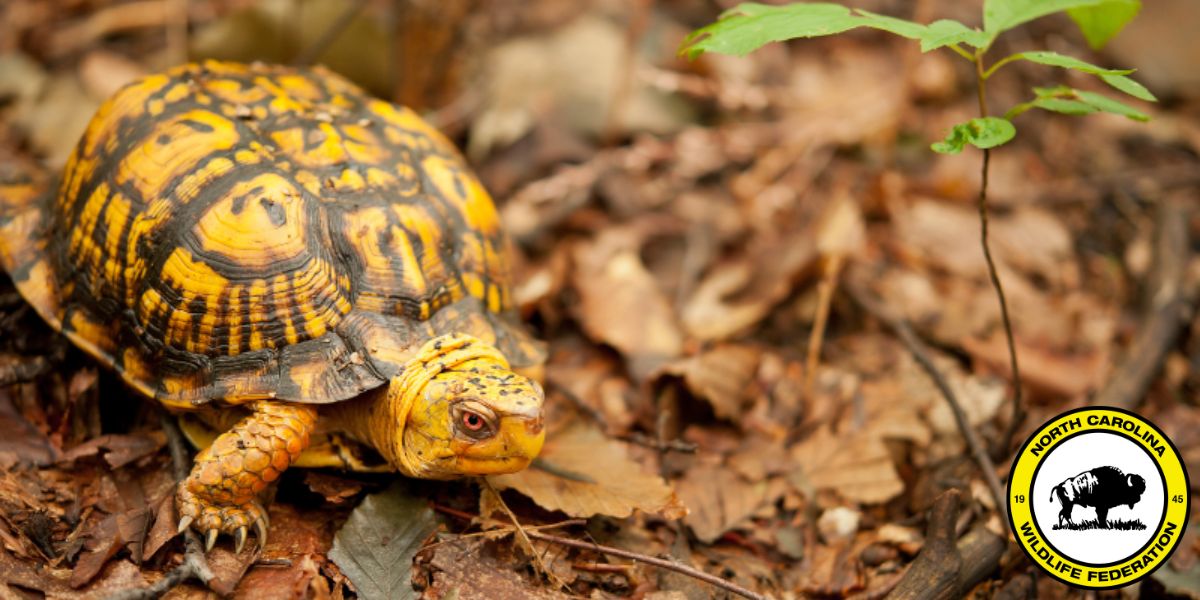
Let’s leave the leaves this fall
Guest blog by Matt Lotti, a lifelong fisherman, backpacker, gardener, native plant enthusiast and all-around nature lover who lives in Clayton.
With the onset of fall, many of us feel the urge to get busy with yard work: raking leaves, pulling up the summer’s spent garden plants and flowers and tidying up our yards. I confess to feeling that urge on an annual basis. The leaves aren’t much of an issue for me because my builder took it upon themselves to remove all the trees from my lot (not a decision I would have made).
Still, my neighbor’s invasive Bradford pear trees deposit a fair amount of leaves into my side yard. Full disclosure: I’m not keen on raking, so I used to run over the leaves with my mower on the mulch setting. I’ve since learned that mowing leaves can damage or destroy habitats or injure wildlife hiding under the leaves.
Now, I leave whole leaves where they lay or rake them into one pile for overwintering insects and around my trees for mulch. Decomposing leaves boosts soil fertility by adding nutrients and allowing for greater water retention. There’s no need to spend money on mulch and fertilizer when you can make your own.
As a result, I’m not bagging the leaves and sending them to the landfill (and saving myself a fair bit of back-straining work). According to the U.S. Environmental Protection Agency, leaves and other yard debris account for a whopping 33 million tons yearly – more than 13 percent of the nation’s solid waste!
But another important reason for leaving the leaves is it benefits many wildlife species, including salamanders, wood frogs, box turtles, earthworms and millipedes. Additionally, thousands of insect species rely on the leaf layer to burrow for the winter (for some, like the noble lightning bug, this is where they lay their eggs). Moth and butterfly caterpillars also overwinter in fallen leaves before emerging in spring.
And even if you can’t resist doing something with the leaves (like me), serving up a batch of whole leaf mulch to your lawn benefits the microorganisms residing there. Those tiny workers need food (and something to do) for the winter.
Similarly, it’s important not to get too enthusiastic about tidying up in the garden. My garden is composed of a grid of eight 4-by-4-foot raised beds that I dote on throughout the growing season, keeping them invasive weed-free (or nearly) and looking their best (at least until it gets too hot to worry about such things).
Fall has gotten away from me the past few years before I’ve had a chance to clean up the garden. So instead, I’ve left the mess. I have to admit it bothered me at first. But I eventually came to appreciate the visual of the spent plants, dried stalks and dead weeds. It reminded me of a productive season. Keep in mind the ideal time to clean up your garden is right before the new growing season in late winter or early spring – it gives insects time to overwinter in the pithy stems throughout the cold months.
Benefits of Untidy Gardens
I soon learned that leaving my garden in an untidy state had other benefits. Incredible creatures like earthworms and millipedes live in and decompose leaf litter and are a food source for wildlife higher up in the food chain. I began to notice increased numbers of backyard bird visitors. They were interested in seeds from dead flowers, tasty liquid in the few tomatoes left on the vine, and insects that were content to feast on – and take refuge in – what was left behind.
A six-foot privacy fence buttresses my backyard, so deer and rabbits don’t get to indulge in these fall treats. But, if your property is more open, you might consider offering up your wilting garden to these residents (you can always put your garden fencing back up in the spring). They’ll be more than happy to help you with the chore of cleaning up.
If you can’t bear to leave things as they lay, consider heaping the leaves, dead plants, weeds and branches in one or more piles in the back of your garden – out of sight. This structure will provide many of the same benefits. Birds, insects and mice will still have somewhere to shelter and search for food, and larger fauna will have a spot to graze.
Let’s face it: Nature is messy by our human standards, certainly ordered and balanced in her own way. Those unaware of the ecological benefits of a natural mess may be inclined to prefer clear garden beds and leaf-free lawns. While garden cosmetics may be nice in the peak of the growing season when we’re spending more time outside, let the offseason be ugly. Allow yourself the reward of admiring the beautiful messes in your yard. You’ll get to it in due time. Spring will be here before you know it. Plus, less time spent dealing with leaves means more time to soak up the crisp fall weather and enjoy the backyard wildlife.
Leaf Tips & Recommendations
The National Wildlife Federation offers these tips and recommendations for leaves in your yard or garden:
- Let leaves stay where they fall or move them into your garden beds to protect your plants’ roots, suppress weeds, preserve soil moisture and eventually break down and return nutrients to the soil.
- Rake leaves off the lawn to use as mulch in garden beds.
- Let leaf piles decompose; the resulting leaf mold can be used as a soil amendment to improve structure and water retention.
- Make compost: Combine fallen leaves (“brown material”) with grass clippings and other “green material” and keep moist and well-mixed. You’ll have nutrient-rich compost to add to your garden next spring.
- Share them with neighbors, friends, schools and others. Some communities will pick up leaves and make compost to sell or give away.
- Build a brush shelter. Along with branches, sticks and stems, you can use leaves to make brush piles that shelter native wildlife.
It’s Time to Start Sowing Seeds and Planting Natives!
Fall is a perfect time to sow seeds, plant shrubs and start or expand your garden. The best months to plant native pollinator seeds for habitat restoration are September through February. Sowing during this period gives seeds a chance to “settle” into the site during the winter and burst into growth in the early spring.
Shrubs provide excellent cover and places to raise young, and plenty of nurseries provide native options in North Carolina. Most of the native pollinator shrubs we list can be found in all three major regions of North Carolina (piedmont, coastal, mountain).
Fall is also a great time to plant native perennials and trees because it allows the roots to establish themselves before the growing season. Be sure to explore NCWF’s Native Pollinator Plants section for resources concerning all things native plants and where to find them. Then, head to The Butterfly Highway for more valuable resources to ensure your garden survives and thrives.
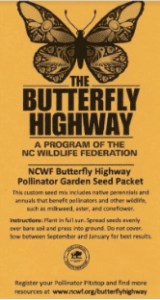
Place your order for NCWF’s Butterfly Highway Garden Seed Packets. Keep one for yourself and gift one to a fellow pollinator lover!
You can also purchase packets of our native pollinator seed mix, which make excellent gifts for family, friends and fellow gardeners! The packet includes up to eight different flowering plant species for pollinators that can create up to 25 square feet of habitat.
- Black-eyed Susan (Rudbeckia hirta)
- Purple Coneflower (Echinacea purpurea)
- Butterfly Weed (Asclepias tuberosa)
- Common Milkweed (Asclepias syriaca)
- Blazing Star (Liatris spictata)
- Beebalm (Monarda fistulosa)
- Heath Aster (Symphyotrichum pilosus)
- Partridge Pea (Chamaecrista fasciculata)


